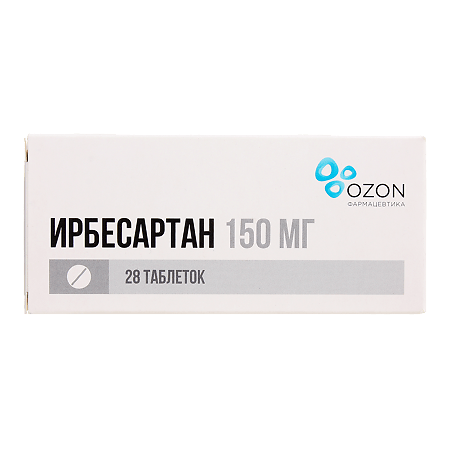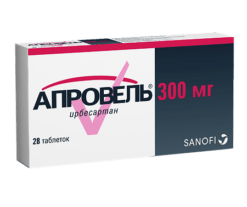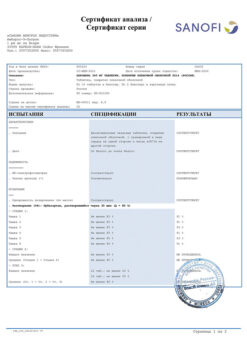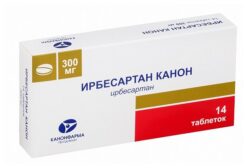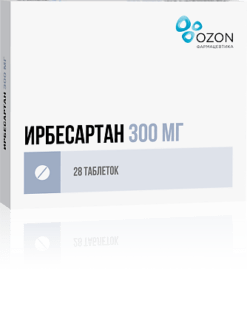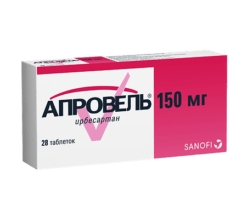No products in the cart.
Irbesartan, 150 mg 28 pcs
€12.60 €11.02
Description
Pharmacotherapeutic group
An angiotensin II receptor antagonist
ATX code
C09CA04
Pharmacodynamics:
Irbesartan is a selective angiotensin II antagonist (type AT1). Irbesartan does not require metabolic activation to acquire pharmacological activity. Angiotensin II is an important component of the renin-angiotensin-aldosterone system (RAAS) and is involved in the pathogenesis of arterial hypertension and sodium homeostasis.
Irbesartan blocks all physiologically relevant effects of angiotensin II regardless of the source or pathway of its synthesis, including its strong vasoconstrictor and aldosterone-secreting effects through AT1 receptors located on the surface of vascular smooth muscle cells and in the adrenal cortex. It has no agonist activity to AT1 receptors and has much more (more than 8500 times) affinity to AT1 receptors than to AT2 receptors (receptors not related to cardiovascular regulation). Irbesartan does not inhibit RAAS enzymes (such as renin angiotensin converting enzyme [ACE]) and does not affect other hormone receptors or ion channels involved in the regulation of blood pressure (BP) and sodium homeostasis. Blocking of AT1 receptors by irbesartan interrupts the feedback loop in the renin-angiotensin system, resulting in increased plasma concentrations of renin and angiotensin II. After irbesartan administration in recommended doses, plasma concentration of aldosterone decreases without a significant effect on serum potassium (average increase is <01 mEq/L). Irbesartan has no significant effect on serum concentrations of triglyceride cholesterol and glucose. Irbesartan has no effect on serum uric acid concentrations or uric acid excretion rate by the kidneys.
The antihypertensive effect of irbesartan is already apparent after the first dose and becomes significant within 1-2 weeks of taking it its maximum effect is reached by 4-6 weeks of treatment. In long-term clinical trials, the maintenance of the antihypertensive effect of irbesartan for more than one year has been observed.
In a single daily oral administration of irbesartan in doses up to 900 mg, the antihypertensive effect is dose-dependent. Irbesartan once daily doses of 150-300 mg will lower BP measured at the end of the interdose interval (24 hours after taking a dose of irbesartan, i.e., before taking another dose of irbesartan) by an average of 8-13/5-8 mmHg (systolic/diastolic BP) compared to placebo. Maximum BP reduction is achieved 3-6 h after a single oral dose and persists for at least 24 h.
The antihypertensive effect of irbesartan before the next dose is 60-70% of the maximum diastolic and systolic BP reduction. Optimal BP reduction within 24 hours is achieved when taking irbesartan once a day. Taking the drug in a dose of 150 mg once daily leads to a hypotensive effect comparable to twice-daily administration of the same dose divided into two doses.
Irbesartan reduces BP in standing and lying position to approximately the same extent. Orthostatic effects are rare, but as with ACE inhibitors, patients with hyponatremia and/or hypovolemia may have excessive BP decreases with clinical manifestations.
The antihypertensive effect of irbesartan and thiazide diuretics is additive. In patients with insufficient BP lowering with irbesartan monotherapy, adding low-dose hydrochlorothiazide (125 mg) once daily to irbesartan monotherapy leads to an additional BP lowering by 7-10/3-6 mm Hg (systolic/diastolic BP) compared to adding placebo.
The efficacy of irbesartan is independent of age or gender. As with other medications that affect RAS, the antihypertensive effect of irbesartan is less pronounced in non-human race patients, but when irbesartan is combined with low-dose hydrochlorothiazide (eg, 125 mg daily) the antihypertensive response in non-human race patients approaches that of Caucasian race patients.
After discontinuation of irbesartan, BP returns to baseline gradually. There is no withdrawal syndrome.
. In a multicenter randomized controlled active substance (amlodipine) and placebo double-blind IDNT clinical trial involving 1715 patients with arterial hypertension and with type 2 diabetes (proteinuria ≥900 mg/day and serum creatinine concentration in the range of 10-30 mg/dL) was shown a 20% (p=0024) reduction (compared with placebo) and a 23% (p=0006) reduction (compared with amlodipine) in the relative risk of first occurrence of any of the following conditions: doubling of serum creatinine concentration development of end-stage renal failure or death from either cause (when comparable BP reduction was achieved with irbesartan and amlodipine).
In a multicenter, randomized, placebo-controlled, double-blind clinical trial investigating the effects of irbesartan on microalbuminuria in patients with arterial hypertension and type 2 diabetes (IRMA 2) involving 590 patients with arterial hypertension and type 2 diabetes having microalbuminuria (20-200 mcg/min 30-300 mg/day) and normal renal function (serum creatinine concentration <15 mg/dL in men and <11 mg/dL in women), the effect of long-term treatment (for 2 years) with irbesartan on the progression of clinically significant proteinuria was evaluated. A 300 mg daily dose demonstrated a 70% reduction in the relative risk of developing clinically significant proteinuria (compared with placebo p=00004) and a 150 mg dose demonstrated a 39% reduction in the relative risk of developing clinically significant proteinuria (compared with placebo p=0085). A slowing in the progression of clinically significant proteinuria was noted as early as three months and continued throughout the entire 2-year period of the clinical trial. The decrease in 24-hour creatinine clearance was not significantly different between treatment groups. Regression of microalbuminuria to normal albuminuria (<20 mcg/min; <30 mg/day) was more frequently observed in the irbesartan group at the 300 mg dose (34%) compared with the placebo group (21%).
Pharmacokinetics:
Absorption
After oral administration, irbesartan is rapidly and completely absorbed its absolute bioavailability is approximately 60-80%. Simultaneous food intake does not significantly affect the bioavailability of irbesartan. After oral administration maximum plasma concentration (Cmax) of irbesartan is reached after 15-2 hours.
Distribution.
The binding to plasma proteins is approximately 96%. Binding with cellular components of blood is insignificant. The volume of distribution is 53-93 liters.
Metabolism.
After oral or intravenous administration of 14C-irbesartan, 80-85% of circulating plasma radioactivity is due to unchanged irbesartan. Irbesartan is metabolized by the liver by oxidation and conjugation to glucuronic acid. The main metabolite in the systemic blood stream is irbesartan glucuronide (approximately 6%). Irbesartan is oxidised mainly by the cytochrome P450 isoenzyme CYP2C9 and CYP3A4 isoenzymes are not significantly involved in the metabolism of irbesartan. Irbesartan is not metabolized by most isoenzymes that are normally involved in drug metabolism (CYP1A1 CYP1A2 CYP2A6 CYP2B6 CYP2D6 or CYP2E1 isoenzymes) and does not cause their inhibition or induction. Irbesartan does not induce or inhibit the CYP3A4 isoenzyme.
Elimination.
Irbesartan and its metabolites are excreted from the body both through the intestine (with bile) and the kidneys. After oral administration or intravenous administration of 14C-irbesartan about 20% of radioactivity is found in the urine and the rest in the feces. Less than 2% of the administered dose is excreted by the kidneys as unchanged irbesartan.
The final half-life (T1/2) of irbesartan is 11-15 hours. Total clearance of intravenously administered irbesartan is 157-176 mL/min and its renal clearance is 3-35 mL/min. When irbesartan is administered daily once daily, the equilibrium plasma concentration (Css) is reached after 3 days with limited plasma accumulation (less than +20%).
Particular patient groups
The effect of sex on the pharmacokinetics of irbesartan
Women (compared to men) had slightly higher plasma concentrations of irbesartan. However, no gender-related differences in T1/2 and accumulation of irbesartan were detected. No dose adjustment was required for irbesartan in women. No gender-related differences in the effects of irbesartan were observed.
Pharmacokinetics of irbesartan in elderly patients
The AUC (area under the pharmacological concentration-time curve) and Cmax values of irbesartan in elderly patients (65-80 years) with clinically normal renal and hepatic function were approximately 20-50% higher than in younger patients (18-40 years). The final T1/2 was comparable. No age-related differences in the effects of irbesartan were observed.
Pharmacokinetics of irbesartan in hepatic impairment
In patients with mild (functional class A or Child-Pugh score 5-6) and moderate (functional class B or Child-Pugh score 7-9) hepatic impairment due to cirrhosis, the pharmacokinetic parameters of irbesartan are not significantly altered.
Pharmacokinetics of irbesartan in renal impairment
In patients with renal impairment or patients undergoing hemodialysis, the pharmacokinetics of irbesartan do not change significantly. Irbesartan is not excreted by hemodialysis.
The effect of race on the pharmacokinetics of irbesartan
The AUC and T|/2 of irbesartan were approximately 20-25% higher in the Negro race without arterial hypertension than in the Caucasian race; their Cmax of irbesartan was nearly equal to that of the Caucasian race.
The pharmacokinetic parameters of irbesartan are linear and proportional in the dose range from 10 to 600 mg; at doses above 600 mg (twice the recommended maximum dose of the drug), the kinetics of irbesartan become nonlinear (reduced absorption).
Indications
Indications
– Arterial hypertension (in monotherapy and in combination with other antihypertensive drugs, such as thiazide diuretics, beta-blockers, long-acting blockers of “slow” calcium channels, BMCC).
– Nephropathy in arterial hypertension and type 2 diabetes mellitus (as part of combination antihypertensive therapy).
Pharmacological effect
Pharmacological effect
Pharmacotherapeutic group
Angiotensin II receptor antagonist
ATX code
C09CA04
Pharmacodynamics:
Irbesartan is a selective angiotensin II antagonist (type AT1). Irbesartan does not require metabolic activation to acquire pharmacological activity. Angiotensin II is an important component of the renin-angiotensin-aldosterone system (RAAS) and is involved in the pathogenesis of arterial hypertension and sodium homeostasis.
Irbesartan blocks all physiologically significant effects of angiotensin II, regardless of the source or route of its synthesis, including its strongly expressed vasoconstrictor and aldosterone-secreting effects realized through AT1 type receptors located on the surface of vascular smooth muscle cells and in the adrenal cortex. It does not have agonistic activity towards AT1 receptors and has a much greater (more than 8500 times) affinity for AT1 receptors than for AT2 receptors (receptors not associated with the regulation of the cardiovascular system). Irbesartan does not inhibit RAAS enzymes (such as renin angiotensin-converting enzyme [ACE]) and does not affect other hormone receptors or ion channels involved in the regulation of blood pressure (BP) and sodium homeostasis. Blocking AT1 receptors with irbesartan interrupts the feedback chain in the renin-angiotensin system, which leads to an increase in plasma concentrations of renin and angiotensin II. After taking irbesartan in recommended doses, the plasma concentration of aldosterone decreases without significantly affecting the potassium content in the blood serum (the average increase is <01 mEq/l). Irbesartan has no significant effect on serum concentrations of triglycerides cholesterol and glucose. Irbesartan does not affect the concentration of uric acid in the blood serum or the rate of excretion of uric acid by the kidneys.
The antihypertensive effect of irbesartan appears after taking its first dose and becomes significant within 1-2 weeks of administration; its maximum effect is achieved by 4-6 weeks of treatment. In long-term clinical studies, the antihypertensive effect of irbesartan was observed to persist for more than one year.
With a single oral dose of irbesartan per day in doses of up to 900 mg, the antihypertensive effect is dose-dependent. Irbesartan, when taken once a day in doses of 150-300 mg, reduces blood pressure measured in the “lying” or “sitting” position at the end of the interdose interval (24 hours after taking a dose of irbesartan, i.e. before taking the next dose of irbesartan) by an average of 8-13/5-8 mm Hg. Art. (systolic/diastolic blood pressure) compared with placebo. The maximum reduction in blood pressure is achieved 3-6 hours after a single oral dose and persists for at least 24 hours.
The antihypertensive effect of irbesartan before taking the next dose is 60-70% of the maximum values for reducing diastolic and systolic blood pressure. The optimal reduction in blood pressure within 24 hours is achieved by taking irbesartan once a day. Taking the drug at a dose of 150 mg once a day leads to a hypotensive effect comparable to twice taking the same dose divided into two doses.
Irbesartan reduces blood pressure to approximately the same extent in the standing and lying positions. Orthostatic effects are observed rarely; however, as with taking ACE inhibitors, in patients with hyponatremia and/or hypovolemia, an excessive decrease in blood pressure with clinical manifestations is possible.
The antihypertensive effect of irbesartan and thiazide diuretics is additive. In patients with insufficient reduction in blood pressure during monotherapy with irbesartan, adding low doses of hydrochlorothiazide (125 mg) once a day to its administration leads to an additional decrease in blood pressure by 7-10/3-6 mm Hg. Art. (systolic/diastolic blood pressure) compared with the addition of placebo.
The effectiveness of irbesartan does not depend on age or gender. As with the use of other drugs that affect the RASS, the antihypertensive effect of irbesartan in patients of the Negroid race is noticeably less pronounced; however, when irbesartan is used simultaneously with low doses of hydrochlorothiazide (for example, 125 mg per day), the antihypertensive response in patients of the Black race approaches the effectiveness of that in Caucasian patients.
After discontinuation of irbesartan, blood pressure returns to its original level gradually. There is no withdrawal syndrome observed.
In the multicenter, randomized, active substance (amlodipine) and placebo, double-blind clinical trial IDNT in 1715 patients with hypertension and type 2 diabetes mellitus (proteinuria ≥ 900 mg/day and serum creatinine concentration in the range of 10-30 mg/dl) a 20% (p = .0024) was shown. reduction (compared to placebo) and 23% (p = 0006) reduction (compared to amlodipine) in the relative risk of the first occurrence of any of the following conditions: doubling of serum creatinine concentration, development of end-stage renal failure or death from any cause (when achieving a comparable reduction in blood pressure with the use of irbesartan and amlodipine).
In a multicenter, randomized, placebo-controlled, double-blind clinical trial examining the effects of irbesartan on microalbuminuria in patients with arterial hypertension and type 2 diabetes mellitus (IRMA 2), involving 590 patients with arterial hypertension and type 2 diabetes mellitus with microalbuminuria (20-200 mcg/min 30-300 mg/day) and normal function kidneys (serum creatinine <15 mg/dL in men and <11 mg/dL in women), the effect of long-term treatment (for 2 years) with irbesartan on the progression of clinically significant proteinuria was assessed. When taking the drug at a dose of 300 mg per day, a 70% reduction in the relative risk of developing clinically significant proteinuria was demonstrated (compared with placebo, p = 00004), and at a dose of 150 mg, a 39% reduction in the relative risk of developing clinically significant proteinuria (compared with placebo, p = 0085). A slowdown in the progression of clinically significant proteinuria was noted after just three months and continued throughout the entire 2-year clinical study period. The decrease in 24-hour creatinine clearance was not significantly different between treatment groups. Regression of microalbuminuria to normal albuminuria levels (<20 mcg/min; <30 mg/day) was more often observed in the irbesartan 300 mg group (34%) compared to the placebo group (21%).
Pharmacokinetics:
Absorption
After oral administration, irbesartan is rapidly and completely absorbed; its absolute bioavailability is approximately 60-80%. Concomitant food intake does not significantly affect the bioavailability of irbesartan. After oral administration, the maximum plasma concentration (Cmax) of irbesartan is achieved after 15-2 hours.
Distribution.
The binding to plasma proteins is approximately 96%. Binding to cellular components of blood is negligible. The distribution volume is 53-93 l.
Metabolism.
After oral or intravenous administration of 14C-irbesartan, 80-85% of the radioactivity circulating in the blood plasma is unchanged irbesartan. Irbesartan is metabolized by the liver by oxidation and conjugation with glucuronic acid. The main metabolite found in the systemic circulation is irbesartan glucuronide (approximately 6%). The oxidation of irbesartan is carried out mainly by the cytochrome P450 isoenzyme CYP2C9; the participation of the CYP3A4 isoenzyme in the metabolism of irbesartan is insignificant. Irbesartan is not metabolized by most isoenzymes that are usually involved in the metabolism of drugs (isoenzymes CYP1A1 CYP1A2 CYP2A6 CYP2B6 CYP2D6 or CYP2E1) and does not cause their inhibition or induction. Irbesartan does not induce or inhibit the CYP3A4 isoenzyme.
Excretion.
Irbesartan and its metabolites are excreted from the body both through the intestines (with bile) and the kidneys. After oral or intravenous administration of 14C-irbesartan, about 20% of the radioactivity is found in the urine and the rest in the feces. Less than 2% of the administered dose is excreted by the kidneys as unchanged irbesartan.
The terminal half-life (T1/2) of irbesartan is 11-15 hours. The total clearance of intravenously administered irbesartan is 157-176 ml/min and its renal clearance is 3-35 ml/min. With a daily single dose of irbesartan during the day, the equilibrium plasma concentration (Css) is achieved after 3 days, while its limited accumulation in the blood plasma is observed (less than +20%).
Special patient groups
Effect of gender on the pharmacokinetics of irbesartan
Women (compared to men) had slightly higher plasma concentrations of irbesartan. However, no gender-related differences in T1/2 and irbesartan accumulation were detected. No dose adjustment of irbe&sartan is required in women. There were no gender-related differences in the effects of irbesartan.
Pharmacokinetics of irbesartan in elderly patients
The AUC (area under the pharmacological concentration-time curve) and Cmax values of irbesartan in elderly patients (65-80 years) with clinically normal renal and hepatic function were approximately 20-50% higher than in younger patients (18-40 years). The final T1/2 are comparable. No age-related differences in the effects of irbesartan were observed.
Pharmacokinetics of irbesartan in liver dysfunction
In patients with mild (functional class A or 5-6 points on the Child-Pugh scale) and moderately severe (functional class B or 7-9 points on the Child-Pugh scale) liver failure due to liver cirrhosis, the pharmacokinetic parameters of irbesartan do not change significantly.
Pharmacokinetics of irbesartan in renal impairment
In patients with impaired renal function or patients undergoing hemodialysis, the pharmacokinetics of irbesartan do not change significantly. Irbesartan is not excreted from the body by hemodialysis.
The influence of race on the pharmacokinetics of irbesartan
In representatives of the Negroid race without arterial hypertension, AUC and T|/2 of irbesartan were approximately 20-25% higher than in representatives of the Caucasian race; The maximum dose of irbesartan in them was almost the same as that in representatives of the Caucasian race.
The pharmacokinetic parameters of irbesartan are linear and proportional in the dose range from 10 to 600 mg; at doses above 600 mg (a dose twice the recommended maximum dose of the drug), the kinetics of irbesartan becomes nonlinear (decreased absorption).
Special instructions
Special instructions
Excessive decrease in blood pressure – patients with hypovolemia.
The use of irbesartan to date has rarely been accompanied by an excessive decrease in blood pressure in patients with arterial hypertension without concomitant diseases. As with the use of ACE inhibitors, an excessive decrease in blood pressure accompanied by clinical symptoms can develop in patients with hyponatremia/hypovolemia (for example, as a result of intensive diuretic therapy for diarrhea or vomiting, following a diet with limited salt intake) as well as in patients on hemodialysis. Before starting the use of irbesartan, it is necessary to correct hypovolemia and/or hyponatremia.
Patients with renal function dependent on RAAS activity
As a consequence of RAAS inhibition, deterioration of renal function can be expected in predisposed patients. In patients with renal function dependent on the activity of the RAAS (patients with arterial hypertension and renal artery stenosis of one or both kidneys; patients with chronic heart failure of functional class III and IV [NYHA classification]), treatment with drugs that affect the RAAS was associated with oliguria and/or progressive azotemia and rarely with acute kidney failure and/or death. The possibility of a similar effect when using angiotensin II receptor antagonists, including irbesartan, cannot be excluded.
Kidney failure and kidney transplant
When using irbesartan in patients with renal failure, periodic monitoring of potassium levels and creatinine concentrations in the blood serum is recommended. There are no clinical data regarding the use of irbesartan in patients who have recently undergone a kidney transplant.
Patients with arterial hypertension and type 2 diabetes mellitus with impaired renal function
The beneficial effect of irbesartan in slowing the progression of renal and cardiovascular disorders had varying degrees of severity in different groups of patients; it was less pronounced in women and non-Caucasian patients.
In the IDNT clinical trial in patients with hypertension and type 2 diabetes mellitus with proteinuria (>900 mg/day) in the subgroup of patients at high risk of renal artery stenosis, no acute early increase in serum creatinine concentration associated with renal artery stenosis was observed in any patient receiving irbesartan.
Double blockade of the RAAS when combining irbesartan with ACE inhibitors or aliskiren
Double blockade of the RAAS when using a combination of irbesartan with ACE inhibitors or aliskiren is not recommended because Compared to monotherapy, there is an increased risk of a sharp decrease in blood pressure, the development of hyperkalemia and impaired renal function.
The simultaneous use of irbesartan with aliskiren is contraindicated in patients with diabetes mellitus or renal failure with a GFR <60 ml/min/173 m2 body surface area (see sections "Contraindications" "Interaction with other drugs") and is not recommended in other patients.
The simultaneous use of irbesartan in combination with ACE inhibitors is contraindicated in patients with diabetic nephropathy (see sections “Contraindications” “Interaction with other drugs”) and is not recommended in other patients.
Hyperkalemia
As with the use of other drugs that affect the RAAS, hyperkalemia may develop during treatment with irbesartan, especially in the presence of renal failure and/or heart disease. In such patients, it is recommended to monitor serum potassium levels.
Aortic or mitral valve stenosis, hypertrophic obstructive cardiomyopathy
As with the use of other vasodilators, caution must be exercised when taking irbesartan in patients with aortic or mitral stenosis or hypertrophic obstructive cardiomyopathy.
Primary hyperaldosteronism
Patients with primary hyperaldosteronism usually do not respond to antihypertensive drugs that act by inhibiting the RAAS. Therefore, the use of irbesartan in such cases is inappropriate.
Patients with coronary heart disease and/or clinically significant cerebral atherosclerosis
As with the use of other antihypertensive drugs, a significant decrease in blood pressure in patients with coronary heart disease and/or severe cerebral atherosclerosis can lead to the development of myocardial infarction or stroke. Treatment of such patients should be carried out under strict blood pressure control.
Impact on the ability to drive vehicles. Wed and fur.:
The effect of irbesartan on the ability to drive vehicles or engage in other potentially hazardous activities requiring increased attention and high speed of psychomotor reactions has not been studied. However, based on its pharmacodynamic properties, irbesartan should not affect the ability to drive vehicles and engage in other potentially hazardous activities (work at height, air traffic controller, work with machinery, etc.). But if dizziness and weakness occur, decreased attention and slower psychomotor reactions may occur. In patients with such adverse reactions, the decision about the possibility of engaging in any potentially hazardous activities should be made by the doctor individually.
Active ingredient
Active ingredient
Irbesartan
Composition
Composition
One tablet contains:
active ingredient: irbesartan – 150.00 mg
excipients: lactose monohydrate – 50.00 mg, povidone – 7.50 mg, microcrystalline cellulose – 27.75 mg, croscarmellose sodium – 6.75 mg, colloidal silicon dioxide – 4.50 mg, sodium stearyl fumarate – 6.50 mg
shell: ready-made mixture “Sepifilm 003” – 4.43 mg, hypromellose – 2.22 mg, macrogol stearate – 0.44 mg, microcrystalline cellulose – 1.77 mg, ready-made mixture “Sepispers AR7001 white” – 0.89 mg: hypromellose – 0.04 mg, propylene glycol – 0.27 mg, titanium dioxide – 0.27 mg, purified water* – 0.31 mg.
Pregnancy
Pregnancy
Pregnancy
There is no experience with the use of irbesartan during pregnancy. Taking into account the fact that when pregnant women took ACE inhibitors in the second and third trimesters of pregnancy, damage and death of the developing fetus were observed, irbesartan, like any other drug that directly affects the RAAS, cannot be used during pregnancy (I II III trimesters).
If pregnancy is diagnosed during treatment with irbesartan, you should stop taking it as soon as possible.
Breastfeeding period
It is unknown whether irbesartan or its metabolites are excreted into breast milk. Irbesartan is contraindicated during breastfeeding. Therefore, after assessing the ratio of the expected benefit of taking the drug for the mother and the potential risk for the child, either breastfeeding or taking irbesartan should be stopped.
Contraindications
Contraindications
Hypersensitivity to irbesartan or to any of the excipients of the drug;
Concomitant use with drugs containing aliskiren in patients with diabetes mellitus or with moderate to severe renal failure (glomerular filtration rate [GFR] <60 ml/min/173 m2 body surface area);
Concomitant use with ACE inhibitors in patients with diabetic nephropathy;
Pregnancy;
Breastfeeding period;
Age up to 18 years (efficacy and safety have not been established).
Hereditary galactose intolerance, lactase deficiency or glucose-galactose malabsorption;
In severe liver failure (functional class C or more than 9 points on the Child-Pugh scale) (no experience in clinical use).
With caution:
Age over 75 years.
For stenosis of the aortic or mitral valve or hypertrophic obstructive cardiomyopathy (HOCM).
In case of hypovolemia, hyponatremia, which occurs, for example, during intensive diuretic therapy, hemodialysis, follow a diet with limited salt intake, diarrhea, vomiting (risk of excessive reduction in blood pressure).
In patients with renal function dependent on the activity of the RAAS, such as patients with arterial hypertension, bilateral or unilateral renal artery stenosis, or patients with chronic heart failure of functional class III-IV (NYHA classification) (see “Special Instructions”).
In case of coronary heart disease and/or clinically significant cerebral atherosclerosis (with an excessive decrease in blood pressure, there is a risk of increased ischemic disorders up to the development of acute myocardial infarction and stroke).
In case of renal failure (monitoring of potassium levels and creatinine concentrations in the blood is required) and recent kidney transplantation (lack of experience in clinical use).
With simultaneous use of non-steroidal anti-inflammatory drugs (NSAIDs), including selective cyclooxygenase-2 (COX-2) inhibitors (increased risk of developing renal dysfunction, including the possibility of acute renal failure and increased potassium levels in the blood serum, especially in elderly patients, patients with hypovolemia [including patients taking diuretics] or with impaired renal function (see section “Interaction” with other drugs”).
When used in combination with ACE inhibitors or aliskiren, compared to monotherapy with double blockade of the RAAS, there is an increased risk of developing an excessive decrease in blood pressure, hyperkalemia and renal dysfunction (see section “Special Instructions”).
Side Effects
Side Effects
The following adverse events are presented in accordance with the following gradations of the frequency of their occurrence (according to the World Health Organization (WHO) classification): very often (≥1/10); often (≥1/100 <1/10); uncommon (≥1/1000 <1/100); rare (≥1/10000 <1/1000); very rare (<1/10000 including isolated reports); unknown frequency (according to available data, it is not possible to determine the frequency of occurrence of an adverse event).
The safety of irbesartan was studied in clinical studies in approximately 5000 patients, including 1300 patients with arterial hypertension who took the drug for more than 6 months and 400 patients who took the drug for one year or more. Adverse events in patients taking irbesartan were usually moderate and transient and their frequency was not related to the dose taken. The incidence of adverse events did not depend on gender, age or race.
In placebo-controlled studies in which 1965 patients took irbesartan (for an average of 1-3 months), discontinuation of treatment due to the development of any clinical or laboratory adverse events was required in 33% of patients taking irbesartan and in 45% of patients taking placebo (the differences were statistically significant).
Adverse events observed in placebo-controlled clinical trials with the use of irbesartan in arterial hypertension, probably or possibly related to its use or without an established relationship with the drug.
The incidence of the following adverse events when taking irbesartan was not statistically significantly different from that when taking placebo.
Nervous system disorders
Common: dizziness, headache;
Uncommon: orthostatic dizziness.
Heart disorders
Uncommon: edema, tachycardia
Disorders of the respiratory system of the chest and mediastinum
Uncommon: cough
Gastrointestinal disorders
Common: nausea/vomiting
Uncommon: diarrhea dyspepsia/heartburn
Disorders of the genital organs and breast
Uncommon: sexual dysfunction
General violations
Common: increased fatigue
Uncommon: chest pain
Laboratory and instrumental data
During controlled clinical studies in patients with arterial hypertension, no clinically significant changes in laboratory parameters were observed. No special monitoring of laboratory parameters is required for patients with arterial hypertension taking irbesartan.
Adverse events observed in controlled clinical studies with the use of irbesartan in patients with nephropathy due to arterial hypertension and type 2 diabetes mellitus (clinical studies IDNT and IRMA2)
Adverse events were similar to those in patients with hypertension with the exception of orthostatic symptoms (dizziness (102%) (placebo 6%), orthostatic dizziness (54%) (placebo 27%) and orthostatic hypotension (54%) (placebo 32%).
Discontinuation rates due to orthostatic symptoms with irbesartan compared with placebo were 03 versus 05% for dizziness, 02 versus 00% for orthostatic dizziness, and 00% versus 00% for orthostatic hypotension, respectively.
Laboratory abnormalities
Hyperkalemia
In the IDNT clinical trial, the percentage of patients with hyperkalemia (>6 mEq/L) was 186% in the irbesartan group compared with 6% in the placebo group. In the IRMA 2 clinical trial, the percentage of patients with hyperkalemia (>6 mEq/L) was 10% in the irbesartan group and no hyperkalemia was observed in the placebo group.
In the IDNT clinical trial, treatment discontinuation rates due to hyperkalemia with irbesartan and placebo were 21% and 036%, respectively. In the IRMA clinical trial, the discontinuation rate due to hyperkalemia with irbesartan and placebo was 05% and 0%, respectively.
Adverse events observed during post-marketing use of irbesartan
Immune system disorders
Very rare: As with all angiotensin II receptor antagonists, very rare cases of allergic reactions such as urticaria and angioedema have been reported.
The following adverse events have been identified with the use of irbesartan since the launch of irbesartan on the market.
Blood and lymphatic system disorders
Unknown frequency: thrombocytopenia
Metabolic and nutritional disorders
Not known frequency: hyperkalemia
Nervous system disorders
Unknown frequency: vertigo
Disorders of the liver and biliary tract
Unknown frequency: increased activity of liver enzymes and bilirubin concentration in the blood, hepatitis, jaundice
Hearing disorders
Unknown frequency: tinnitus
Musculoskeletal and connective tissue disorders
Unknown frequency: myalgia
Renal and urinary tract disorders
Unknown frequency: impaired renal function, including cases of renal failure in patients at risk (see section “Special instructions”).
General violations
Unknown frequency: asthenia.
Interaction
Interaction
Based on these in vitro studies, no interaction of irbesartan is expected with drugs metabolized by the isoenzymes CYP1 Al CYP1A2 CYP2A6 CYP2B6 CYP2E1 or CYP3A4. Irbesartan is mainly metabolized by the CYP2C9 isoenzyme and is subject to glucuronidation to a lesser extent. No significant pharmacokinetic and pharmacodynamic interactions were observed when irbesartan was co-administered with warfarin, a drug metabolized by the CYP2C9 isoenzyme. The effects of inducers of the CYP2C9 isoenzyme such as rifampicin on the pharmacokinetics of irbesartan have not been studied.
Irbesartan does not change the pharmacokinetics of digoxin and simvastatin.
When irbesartan is co-administered with hydrochlorothiazide or nifedipine, the pharmacokinetics of irbesartan does not change.
With medicinal products containing aliskiren
The simultaneous use of irbesartan with drugs containing aliskiren is contraindicated in patients with diabetes mellitus or moderate to severe renal failure (GFR <60 ml/min/173 m2 body surface area) and is not recommended in other patients (see sections "Contraindications" "With caution" "Special instructions").
With ACE inhibitors
The use of irbesartan in combination with ACE inhibitors is contraindicated in patients with diabetic nephropathy and is not recommended in other patients (see sections “Contraindications”, “With caution”, “Special instructions”).
With potassium supplements and potassium-sparing diuretics, heparin
Based on the experience gained with the use of other drugs that affect the RAAS with the simultaneous use of potassium preparations; salt substitutes containing potassium; Potassium-sparing diuretics or other drugs that can increase potassium levels in the blood (heparin) can sometimes significantly increase serum potassium concentrations, which requires careful monitoring of plasma potassium levels in patients during treatment.
With NSAIDs including selective COX-2 inhibitors
With the simultaneous use of angiotensin II receptor antagonists and NSAIDs (including selective COX-2 inhibitors acetylsalicylic acid (more than 3 g/day) and non-selective NSAIDs), the antihypertensive effect of irbesartan may be weakened. This combination should be used with caution, especially in elderly patients and patients with hypovolemia. In elderly patients with hypovolemia or impaired renal function, the use of NSAIDs including COX-2 inhibitors concomitantly with angiotensin II receptor antagonists including irbesartan may lead to deterioration of renal function including the possible development of acute renal failure. These effects are usually reversible. Before starting combination therapy, patients need to restore their blood volume and also monitor renal function before starting therapy and periodically during combination therapy.
With lithium preparations
Increased serum concentrations of lithium and increased toxicity have been reported with the simultaneous use of lithium salts and irbesartan. If there is a need to use this combination, it is recommended to regularly monitor the concentration of lithium in the blood serum during treatment.
With diuretics and other antihypertensive drugs
With simultaneous use of irbesartan and other antihypertensive drugs, the antihypertensive effect may be enhanced. Irbesartan was used concomitantly with other antihypertensive drugs such as long-acting beta-blockers BMCC and thiazide diuretics without any problems.
Previous treatment with high doses of diuretics may lead to hypovolemia and an increased risk of excessive reduction in blood pressure at the beginning of treatment with irbesartan.
Overdose
Overdose
Experience with the use of the drug in adults in doses up to 900 mg/day for 8 weeks did not reveal any toxicity.
There is no specific information regarding the treatment of irbesartan overdose. Constant monitoring of the patient’s condition should be established and, if necessary, symptomatic and supportive therapy should be provided. In case of overdose, it is recommended to induce vomiting and/or perform gastric lavage. Irbesartan is not removed from the body by hemodialysis.
Symptoms of overdose – a pronounced decrease in blood pressure, tachycardia, rarely – bradycardia.
Storage conditions
Storage conditions
In a dry place, protected from light, at a temperature not exceeding 25 ° C. Keep out of the reach of children.
Shelf life
Shelf life
3 years.
Do not use the drug after the expiration date indicated on the package.
Manufacturer
Manufacturer
Ozon, Russia
Additional information
| Shelf life | 3 years. Do not use after the expiration date on the package. |
|---|---|
| Conditions of storage | Store in a dry place protected from light at a temperature not exceeding 25 °С. Keep out of reach of children. |
| Manufacturer | Ozon, Russia |
| Medication form | pills |
| Brand | Ozon |
Other forms…
Related products
Buy Irbesartan, 150 mg 28 pcs with delivery to USA, UK, Europe and over 120 other countries.

